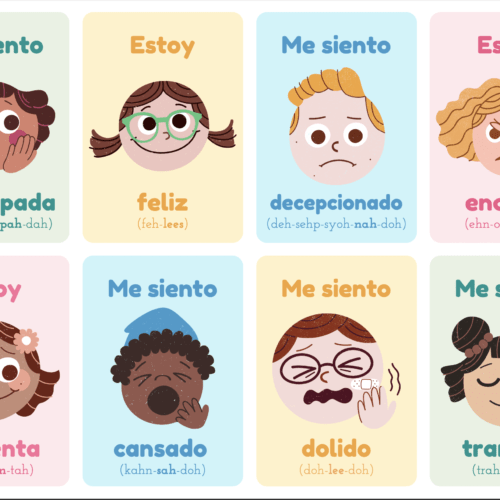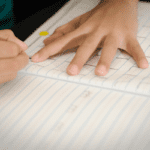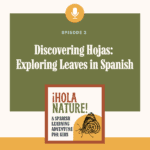
Social Emotional Learning in a Bilingual Home – Free Spanish Emotion Flashcards
As an educator and parent, I have seen and felt the pressure of getting kids started early on the right path. When teaching preschool, we focused on numbers and shapes and colors and beginning letter sounds. As a Kindergarten teacher there was a very clear check list with things each child needed to learn in order to move on. While I realize it is incredibly important for children to learn how to read and write, and for them to feel on track with their peers, I also think we need to shift our priorities just a bit.
What should children learn before they focus on academics?
Social Emotional Learning isn’t a new concept but it has definitely grown in popularity throughout schools in the US for the last few years. It is essentially helping and teaching our children (and ourselves) how to identify and manage emotions, set positive goals, cultivate empathy and compassion and also how to maintain healthy relationships with others and ourselves. As parents it seems like an obvious priority, of course we want our children to be able to do all of those things!

What many parents and educators have a hard time realizing though, is that those skills all need to be taught and cultivated. I can’t even begin to tell you how many teenagers I have taught (and adults I have worked with) that could not identify their emotions and did not have healthy coping skills to manage them. It doesn’t need to be overwhelming or a big production – you don’t need any special materials or tools. We can teach our kids SEL at home and bring our language learning into it at the same time! It is never too late to get started.
Top Tips for teaching SEL in a bilingual home
Teach your children how to take a deep breath!
This is número uno my friends. I cannot tell you how grateful you will be when your toddlers and teenagers know how to take a calming breath and when they really start using this skill. Maybe it is even something that you need to work on too (I am constantly reminding myself!) There are some fun ways that you can teach this.
With my really young kiddos, I taught them this little rhyme Arriba en el cielo, abajo en el suelo – Up in the sky, down on the ground. We would bring our hands up to take a deep breath and down on the ground for our exhale. You can also pretend like you are smelling cookies baking for an inhale and exhale like you are blowing bubbles.
I also talk to my children whenever I feel upset or frustrated and model how I take a deep breath. In any stressful moment I always ask my kids: want to take a deep breath with me? Even if they don’t want to, I still do it myself! Before you know it, they will be doing the same and it is a skill that will serve them for a lifetime.
Spanish Phrases to use:
Respirar hondo (rehs-pee-rah ohn-doh) – deep breath
Inhalar (een-ah-lahr) – to inhale
exhalar (ehk-sah-lahr) – to exhale
La respiración profunda (rehs-pee-rah-syohn proh-foon-dah) – deep breathing
Vamos a respirar hondo juntos (bah-mohos ah rehs-pee-rahr ohn-doh hoon-tohs) – Let’s take a deep breath together


Help them identify emotions
Children do not inherently have the language they need to talk about their big feelings. We need to help them identify what sad feels like, or angry or frustrated or disappointed. There are two great ways to do this. You can first, just ask them questions when they are upset and help them identify their emotions in the moment.
- You seem really upset are you sad
- Are you feeling angry too?
- That sounds really disappointing, are you feeling disappointed?
- I would feel really frustrated if that happened to me, is that how you’re feeling?
- Wow! I can’t wait! Are you excited? I am.
Using these prompts can help children learn how to identify their own feelings and they can also connect with you more. If you let them know it is okay to be feeling all of these feelings, they will feel safer trusting you with them.

I also love to use emotions cards and pictures to help children learn to identify feelings and emotions when they are in a calmer space. There are so many activities that you can do with these cards so your child can really interact and feel playful with emotions. There is a set of picture-based emotion cards with real kiddos in my Con mi Familia Spanish course (there is a whole week all about emotions!) but I wanted to make a little freebie for you all too.
If you click this link you can get your own Spanish emotions flashcards with pronunciation guides on each one
You can play matching games, charades, hide and seek, Simon says…so many ways to bring play into this!
Spanish Phrases to Use:
¿Cómo te sientes? (koh-moh teh syehn-tehs) – How do you feel?
¿Estás….? (ehs-tahs) – Are you…?
Me siento…(meh syehn-toh) – I feel…
How do you bring SEL into your learning at home?
This is the tip of the ice berg but really, just these two things are huge for helping your children feel and manager their emotions. It is amazing what a relief it can be just being able to take a deep breath and put into words how you are feeling and being able to bring your Spanish learning into this is just a bonus! Stay tuned for more info and advice on bringing SEL into your learning at home in the next few weeks.









